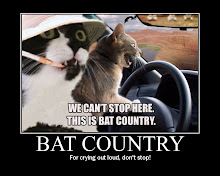Forgive my venom; I really don’t understand the kawaii craze. Yes, I love the occasional puppy or kitten, but I just don’t understand why some people make it into a lifestyle. I personally think that when people make a conscientious decision to act clumsy, air-headed, and downright retarded sometimes, it stunts intellectual growth. However, knowing that my professor is a Hello Kitty fanatic, I must grit my teeth, put aside my personal feelings, and dive right in.
Anyhow, I need two “kawaii” pictures…
Here is my first one.

City Glow
Chiho Aoshima
2005
Courtesy Blum & Poe
Despite my aforementioned dislike for the “kawaii,” I find this painting to be a work of freaking genius. It depicts a nighttime city skyline with a forest/jungle/conglomeration of various floras beneath it. The usually threatening image of the city is softened by the skyscrapers which don’t have sharp edges (except the radio receivers on their roofs). The city skyscrapers all have faces, but that is the extent of their anthropomorphication (if that is even a word). Most of the skyscrapers have curious or confused faces, and for good reason! There appear to be yellow buildings popping up out of the ground. What do they represent? The expansion of the urban complex? Man’s unquenchable need to create? Well, judging by the phallic tower that appears to have testicles on the far right side of the painting, I’m going to guess that it’s the end of innocence. The pheasant flying by could also represent the mystique of nature which is being squelched by development. The buildings, innocent as they are, are amazed and create the typical kawaii “whoa” face that is so popular in anime and manga. Don’t let my cynicism fool you; I really do like this painting. It was a nice reprieve from the majority of KaiKai KiKi’s work involving repressed Jungian sexual desires (seriously, that Mr. guy has…issues…). Anyway, next picture.

Now, this is the kind of cute that I can get behind. I wish I could give the source information of this photo, but I honestly couldn’t. I got this photo in an email from my father who thought that I would like it. Well, I do. And why not? All the ascetic triggers are here for the activation of the cute glands. The baby ducks are small, misshapen, they obviously can’t take care of themselves so they must rely on their mommy (which simultaneously inspires maternal instincts), they have big heads, and they are all crowded on to their mom’s back in a way that makes it look like they could fall off at any minute. The viewer is seized with an impulse to grab the ducklings, cuddle them, and swear that they will protect them. Quintessential kawaii.

Only an Otaku would know who Nicholas D. Wolfwood is. You are an Otaku. Kawaii-craze or not. Deal with it. ^_^ <--かわいいえがおでしょう?
ReplyDeleteOn the other hand, I agree with your analysis of the KaiKai Kiki image. One question, though--do you think the buildings are at all centered around phallic imagery? Also, the way that one building in the middle is shaped is interesting--it seems amorphous, almost in the middle of being formed.